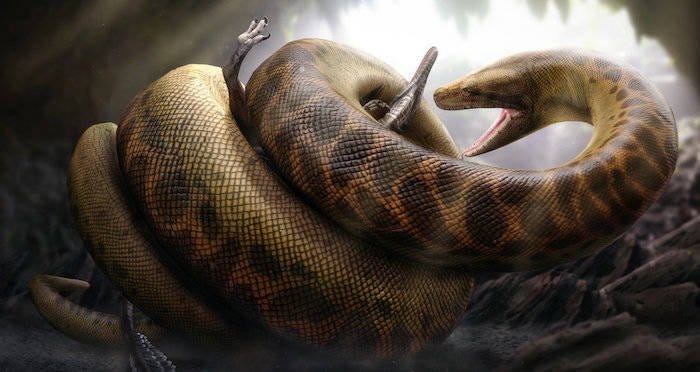
The movie Anaconda depicted a scary, inordinately large, green anaconda that soon became the snake of everyone’s nightmares. The huge size of that anaconda, of course, was merely a work of fiction. Anacondas are not that large. However, it would be wrong to say that gigantic snakes are only restricted to works of fiction. Nearly 60 million years ago, a species of snakes called the Titanoboa established its place in the ecosystem as the largest snake ever discovered. Before 2009, the record for the world’s largest snake was held by Gigantophis, which could grow up to 35 feet in length. However, with the discovery of the fossils of Titanoboa in the Colombia region, Gigantophis was pushed to second place. Titanoboa could grow up to 47 feet in length. In terms of width, the Titanoboa was nearly 3 feet wide, which is more than the length of a human arm.
To put it in the modern context, the length of a Titanoboa could extend to nearly five floors of an average apartment building. The Titanoboa lived during the Paleocene Epoch and is related to modern day anacondas and boas. The Paleocene Epoch lasted from 65.5 – 55.8 million years ago, and is the period immediately after the extinction of the dinosaurs.
The discovery of the Titanoboa fossils was made in 2009, when nearly 30 fossils were found in the coal mines of Colombia. The credit for the discovery of these fossils goes to Jonathan Bloch and Carlos Jaramillo. Not only in height but also in weight the Titanoboa was unbelievably heavy. An average Titanoboa is estimated to weigh nearly 1133 kilograms (the weight of an average car is 1179 kilograms). Thus, under the weight of a Titanoboa, without it applying any force at all, it would be like being crushed under the weight of a car.
In terms of habitat, the Titanoboa occupied the tropical rainforests found in the Cerrejon region, Colombia. This was home to yet another extraordinary animal species - the Dyrosaurus, which existed alongside the Titanoboa. Known as Acheron, it was a relative of the crocodile and is estimated to be strong enough to be a competitor to the Titanoboa.
The Titanoboa was assumed to be an apex predator. The Smithsonian ran a couple of stimulation videos to estimate the results of a fight between the Titanoboa and the Tyrannosaurus Rex. However, further discoveries clarified that the Titanoboa had a piscivorous diet - it fed on fish. The anatomy of the palate, the teeth, the jaw, and the number of teeth, all indicated that the Titanoboa primarily fed on fish.
It is estimated that in size the Titanoboa was so immensely large because of the humid temperatures in the rainforest area. The temperature, estimated to be at 90 degrees Fahrenheit, was considered to be an optimal environment for cold blooded animals, which kept their metabolism at an all time high. Due to this, their size kept on expanding. However, this theory also faces criticism. It is argued that in accordance with this theory, even the modern day lizards living in such perennially humid environments should be huge in terms of size.
Whatever the case may be, it is sure that the Titanoboa makes all the modern day snakes look puny. The largest snake today, the green anaconda, is merely one-third the size of the Titanoboa and their average weight is only 250 kilograms. This is nothing compared to the now-extinct Titanoboa. It leaves no doubt that the Titanoboa was the uncrowned king of snakes, and would have been a living nightmare had it been alive today.
Editorial Support: Phoenix Content India



